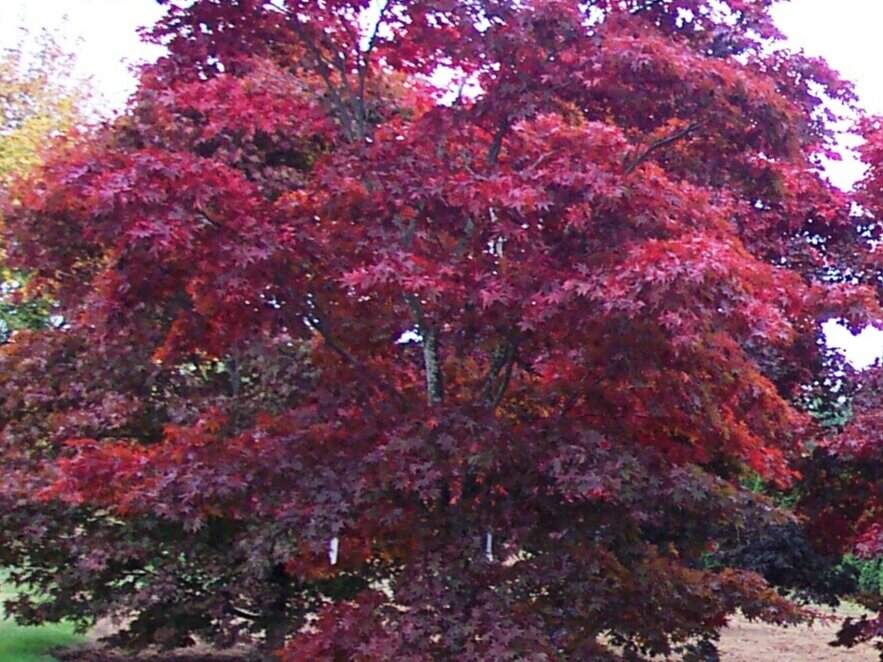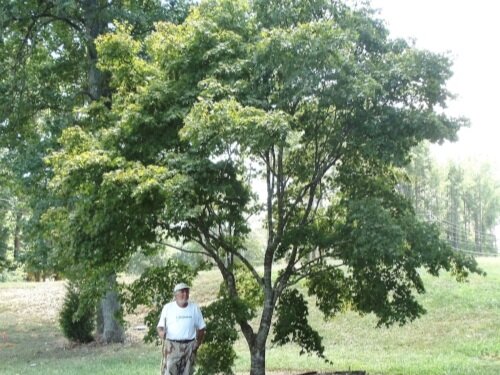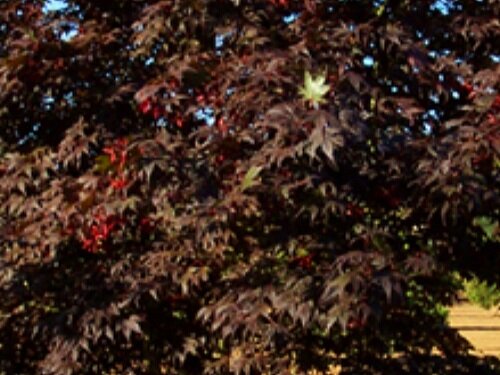Acer palmatum ‘Bloodgood’




Description:
Named as early as the late 19th century in Long Island, New York, 'Bloodgood' is probably the most well known Japanese Maple all over the world. In fact it has become the standard by which all other red Japanese Maples are measured.
The dark rich purple spring color and brilliant red fall color are beautiful. Bright red Samaras are displayed during late spring and early summer that contrast nicely with the dark purple foliage, and stems of new growth are dark red which also gives it a winter interest. 'Bloodgood' will hold its color all summer long in most climates, but in the hot climate of the Southeastern U.S. it will turn bronze or even green by late August and will burn slightly in full sun while young.
10 Year Size:
Height: 16-18 feet Width: 16-18 feet
Acer palmatum ‘Bloodgood’ will grow to be a large upright tree over time. While Bloodgood is one of the larger growing Japanese maple varieties, it is still quite small compared to other trees. Bloodgood should still be an option for most landscapes.
The width of Bloodgood can get to be close to the same as the height. Bloodgood forms a large canopy at the top that is often nearly as wide as it is tall. If you are looking for a large growing Japanese maple that could eventually provide a little shade, then Bloodgood is going to be one of your best options.
COLORS:
Acer palmatum ‘Bloodgood’ emerges in the spring with dark red, almost wine colored leaves. There will be variation in the red color depending on the amount of sun that your Bloodgood Japanese maple tree is getting. These leaves then fade to a burgundy or sometimes even green color in the summer time as the temperatures rise. Come fall, Bloodgood turns a bright red color before eventually dropping its leaves for the winter.
STRUCTURE:
Acer palmatum ‘Bloodgood’ will develop into a large, upright Japanese maple with a robust canopy. Bloodgood has a strong branch structure that is impressive in the landscape. Bloodgood is one of the best Japanese maple trees for providing shade due to large canopy of mature trees.
HISTORY:
Many people believe that Acer palmatum ‘Bloodgood’ was named for its dark red color, but it was actually named in the late 19th century by Bloodgood Nursery in New York. Bloodgood Nursery was the first American nursery to sell this tree, so they named it after their own nursery. It is unclear where they first received the tree, because trees were not actively coming out of Japan at that time. It is thought that Bloodgood Nursery likely received the tree from the Netherlands as a select Atropurpureum that was displaying exceptionally nice color.
Regardless of its origins, Bloodgood is probably the most popular Japanese maple in the world and has become the standard by which all other red upright Japanese maples are judged. Acer palmatum ‘Bloodgood’ was also a recipient of the prestigious Award of Garden Merit from the Royal Horticultural Society for its outstanding qualities.
HARDINESS:
USDA Plant Hardiness Zones: 5-9
AHS Heat Zone: 5-10
Sunset Climate Zone: 3-10, 12, 14-24, 28-37
Japanese maples such as Acer palmatum ‘Bloodgood’ are hardy in most regions of the United States. The only areas where they will not work are areas of extreme cold or extreme hot temperatures. Areas of extremely high altitudes may also not work particularly well for Japanese maples. Japanese maples will also thrive better in areas of consistent rainfall. These zones are general rules, but exceptions do apply. Do your own research on your particular area before purchasing a Japanese maple, but Japanese maples are generally a very hardy tree.
SUN TOLERANCE:
The majority of Japanese maples are going to prefer some variation of morning sun and afternoon shade. While this is great in a perfect world, it is not realistic for every Japanese maple. Many Japanese maples can handle much more sun, such as Acer palmatum ‘Bloodgood’. Bloodgood can handle up to all day sun with little issues. However, better color will be maintained in the summer if given a break from the hot afternoon sun.
PLANTING:
Planting A Japanese Maple In The Ground:
All Japanese maples should be planted slightly elevated on a mound. This can be done by leaving a small portion of the rootball above ground level when planting. Dirt is then brought up to the sides covering up the majority of the roots. The end result is an elevated mound up to the base of the tree. The root flare where the trunk ends and the roots begin should be visible above ground level when planting is finished. A light layer of pine straw or pine bark mulch around the tree is all the mulch that is needed for a Japanese maple. Don’t pile too much mulch up against the trunk of the tree.
Planting A Japanese Maple In A Container:
Japanese maples like Bloodgood work great as container plants. When planting a Japanese maple in a container, we typically recommend a 50/50 mix of soil conditioner and potting soil. This will provide a good growing medium for your tree while also allowing for proper drainage. You still want to plant your Japanese maple slightly elevated in the container with the root flare above the dirt level.
SOIL REQUIREMENTS:
Japanese maples like Acer palmatum ‘Bloodgood’ prefer slightly acidic soils, but they are very adaptable to nearly any soil. We rarely recommend any soil amendments when planting a new Japanese maple other than possibly some soil conditioner or top soil to fill in here and there. The main thing to consider with soil is the drainage. Japanese maples love well draining soil. They like to get wet, but they don’t like to stay wet. This is another reason that we recommend planting Japanese maples elevated on a mound, so that the water can drain out from the roots of the Japanese maple tree.
WATERING:
Japanese maples like moist well draining conditions. They like good soakings, but then that water needs a chance to drain away. Japanese maples do not like wet feet. When you first plant your Bloodgood, you should water no more than once or twice per week depending on the time of the year. Your Bloodgood Japanese maple may need more water when planted in the summer versus if it is planted in the fall or winter. After a couple of months you can back off on the watering a little bit as the tree is getting established. There is no need to water your Bloodgood while it is dormant unless there is no rain for several weeks. Your Bloodgood should be able to live off of nothing but rain water after the first year in the ground. You can give it a drink again if there hasn’t been any rain for a couple weeks or so. Important: most people have more issues overwatering their Japanese maple than under watering it. Don’t kill your Japanese maple tree with kindness.
SPECIAL CARE:
There is very little special care required with Japanese maples, including Acer palmatum ‘Bloodgood’ You want to fertilize your Japanese maple in the spring with an organic Japanese maple fertilizer such as Happy Frog. This will ensure that your Bloodgood Japanese maple is receiving all the nutrients it needs to flourish in your yard.
PRUNING:
You can prune your Bloodgood Japanese maple in the winter when the tree is dormant. This is the best time to prune a Japanese maple because the energy of the tree is not flowing as actively as it may in the spring or summer. Bloodgood takes very well to pruning and can become an elegant tree over time with proper care. There are many different ways to prune a Japanese maple. As long as you only prune in the winter and never take more than a third of the tree off at any given time, then it is hard to go wrong. Pruning is all about your personal preferences and making your tree look good for you.
